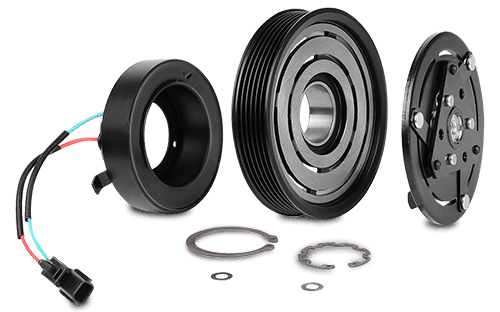Your car's air conditioning system is a marvel of engineering, providing cool and comfortable temperatures even on the hottest summer days. At the heart of this system lies the AC compressor, responsible for circulating refrigerant and regulating the cooling process. But how does this compressor start and stop? Enter the magnetic clutch, an ingenious component that seamlessly engages and disengages the compressor, ensuring efficient operation and energy conservation. In this article, we'll unveil the mystery behind the magnetic clutch, exploring its inner workings and the crucial role it plays in your vehicle's AC system.
The Fundamentals of the Magnetic Clutch
A magnetic clutch is a device that uses electromagnetic force to engage or disengage a rotating shaft from its driven component. In the case of an AC compressor, the magnetic clutch acts as a coupling mechanism, allowing the compressor to be powered by the engine's crankshaft pulley when needed, and disengaging it when cooling is not required. Magnetic clutch consists of three main components: the electromagnetic coil, the rotor (or pulley), and the armature (or friction disc). Electromagnetic coil is mounted on the compressor's housing, while the rotor is connected to the engine's crankshaft pulley via a belt or direct drive. The armature is attached to the compressor's input shaft.
How the Magnetic Clutch Engages the AC Compressor
When you turn on your vehicle's air conditioning system, a signal is sent to the magnetic clutch, energizing the electromagnetic coil. This coil creates a powerful magnetic field that attracts the armature towards the rotor, causing them to make contact and engage. As the rotor spins, driven by the engine's crankshaft pulley, its rotational force is transferred to the armature and, consequently, to the compressor's input shaft. This mechanical connection allows the compressor to start circulating refrigerant, initiating the cooling process.
The Disengagement Process
When you turn off the air conditioning or the system reaches the desired temperature. The signal to the magnetic clutch is interrupted. Causing the electromagnetic coil to de-energize. Without the magnetic field, the armature disengages from the rotor. Breaking the connection between the compressor and the engine's crankshaft pulley. This disengagement process is crucial as it prevents the compressor from unnecessarily drawing power from the engine when cooling is not required. Improving fuel efficiency and reducing wear and tear on the AC system components.
The Benefits of a Magnetic Clutch
The magnetic clutch offers several advantages over traditional mechanical clutches, making it an indispensable component in modern AC systems:
- Smooth Operation: The magnetic clutch engages and disengages seamlessly, without the need for physical contact or wear-inducing friction. This ensures a smooth and consistent operation of the AC compressor.
- Energy Efficiency: By disengaging the compressor when cooling is not needed, the magnetic clutch helps reduce the engine's workload, improving fuel efficiency and reducing emissions.
- Extended Lifespan: With minimal physical contact and wear, the magnetic clutch and other AC system components have a longer lifespan, reducing maintenance costs and increasing reliability.
- Precise Control: The magnetic clutch can be engaged and disengaged instantaneously, allowing for precise control over the AC system's operation and temperature regulation.
Maintaining Your Magnetic Clutch
While the magnetic clutch is a robust and reliable component, it requires some maintenance to ensure optimal performance. Here are a few tips to keep your magnetic clutch in top condition:
- Regular Inspections: During routine vehicle maintenance, have your mechanic inspect the magnetic clutch for signs of wear, damage, or contamination from leaking refrigerator or lubricant.
- Proper Lubrication: Ensure that the compressor and its components are properly lubricated according to the manufacturer's recommendations. Insufficient lubrication can lead to premature wear and failure of the magnetic clutch.
- Electrical Checks: Have the electrical system checked, including the wiring and connectors that supply power to the magnetic clutch's electromagnetic coil. Faulty electrical connections can prevent the clutch from engaging or disengaging properly.
- Belt Tension and Alignment: Maintain the correct tension and alignment of the drive belt that connects the engine's crankshaft pulley to the compressor's rotor. Improper belt tension or misalignment can cause excessive wear and potential failure of the magnetic clutch.
Understanding the Role of the Magnetic Clutch in AC System Diagnostics
When troubleshooting issues with your vehicle's air conditioning system. The magnetic clutch can provide valuable clues about the root cause of the problem. Here are some common scenarios:
- Clutch Not Engaging: If the magnetic clutch fails to engage. It could indicate a problem with the electrical supply, a faulty electromagnetic coil. Or a stuck fitting due to contamination or lack of lubrication.
- Clutch Slipping or Disengaging: If the clutch engages but slips or disengages prematurely. It may point to issues with the armature surface. Worn or damaged clutch facings, or incorrect air gap between the armature and rotor.
- Noisy Operation: Excessive noise from the magnetic clutch can be a sign of worn bearings, misalignment. Or other mechanical issues within the compressor or clutch assembly.
By understanding the role of the magnetic clutch and its potential failure modes. Technicians can diagnose and repair AC system problems more efficiently. Ensuring optimal cooling performance and extended component life.
The Future of Magnetic Clutches in AC Systems
As automotive technology continues to evolve, magnetic clutches are likely to play an increasingly important role in AC systems. With the growing emphasis on energy efficiency and emissions reduction, the ability of magnetic clutches to disengage the compressor when not needed will become even more valuable. Additionally, advancements in materials and manufacturing processes may lead to more durable and long-lasting magnetic clutches. Further reducing maintenance requirements and extending the lifespan of AC systems.
Conclusion
- The magnetic clutch is a crucial component that powers your vehicle's AC compressor, enabling efficient cooling and energy conservation. By harnessing the power of electromagnetic force, this ingenious device seamlessly engages and disengages the compressor. Ensuring smooth operation and precise temperature control. Understanding the inner workings of the magnetic clutch and its role in the AC system can help you better maintain and diagnose potential issues. Prolonging the life of your vehicle's cooling system. So, the next time you crank up the air conditioning on a hot summer day. Take a moment to appreciate the unsung hero that makes it all possible – the magnetic clutch.
 tuningblog.eu Your magazine about tuning the car
tuningblog.eu Your magazine about tuning the car



